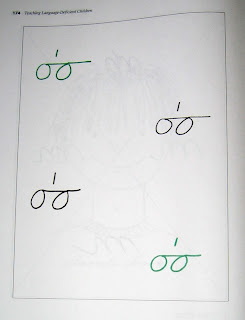Yesterday, I gave an overview of the Association Method. Today, I will explain what I know about the first unit of language (which is not much since we skipped it)! I learned nearly everything I know in the teaching manual for the Association Method. You can attend multi-level courses at USM Dubard, which offers a certification program, but that did not seem feasible for a homeschooling mother of two!

Phonemes

Once children have learned several symbols, they can play simple card games like Go Fish and Concentration with cards made from the symbols. Pro-Ed does offer materials that make preparing to teach this unit less time consuming, such as 282 4 x 6 phoneme manuscript cards. I know you might be thinking playing Concentration with phoneme cards is no big deal. If so, I dare you to watch Connor's Story and NOT CRY!
Two-Sound Syllables

Nouns
Once they can read, repeat from lip-reading or hearing, and write ten syllables from cross drills, children transition to cross drills in the final phase of the first unit, which trains the eye in left to right, top to bottom reading. I Can Talk's page on the Association Method shows a boy doing a cross drill at the dry erase board and another boy reading from his personal story book, where all drills and stories are stored. Simple nouns are drawn from each set of cross drills, formed into seven groups of sound patterns. Each group increases the complexity of the word with V representing by phonemes having a vowel sound and C representing those with a consonant sound:
Group 1 - CV or VC
Groups 2 and 3 - CVC
Group 4 - CVC or CVV
Group 5 - CVC or VCC or CCV or CVV
Group 6 - CVCC or CCVC
Group 7 - CVCV or CVCVCV and beyond
Appendices
The appendices of the manual are quite extensive and necessary to implement the pogram. Appendix A covers phonetics and the Northampton symbols. Appendix B has over 140 pages of sample content from a typical child's book for all three units of language. Appendix C provides a standard vocabulary list of nouns taught in the first unit of language, while Appendix D provides more detail on sample stories used in the second and third units. Appendix E outlines a typical program showing the progression from first phonemes to first syllables to words for a chlid with dyslexia. That's not bad for $52 plus shipping!




Wow! This is fascinating. Your blog is one of my very favorite autism resources.
ReplyDeleteThank you for sharing so much info. I have been happy that my son is enjoying Winnie the Pooh by A.A. Milne. I BELIEVE IN CM PRINCIPLES. My son turned eight. He is interested in learning AGAIN. I actually have been happy to hear him say "ated" and I know that we need to work on syntax. Love your blog and hope that you all feel better so you may enjoy the upcoming wedding. sincerely, DianeG.
ReplyDeleteSteph, I tried to read your blog the other day and it turned up nada? Wha's up??????
ReplyDeleteDianeG., I am so excited for you. I have the exact same conviction about Cm's principles!!!! The syntax will come in time. If not, there's always the association method!